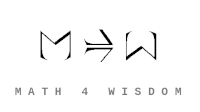- MathNotebook
- MathConcepts
- StudyMath
- Geometry
- Logic
- Bott periodicity
- CategoryTheory
- FieldWithOneElement
- MathDiscovery
- Math Connections
Epistemology
- m a t h 4 w i s d o m - g m a i l
- +370 607 27 665
- My work is in the Public Domain for all to share freely.
- 读物 书 影片 维基百科
Introduction E9F5FC
Questions FFFFC0
Software
Andrius Kulikauskas: Welcome! This is where I record my latest research notes.
John A. Shuster. “HeartMinds” in HeartMind space.
Eckhard Meinrenken. Clifford algebras and Lie groups. Chapter 1. Symmetric bilinear forms., Chapter 2. Clifford algebras.
Marc Lachieze-Rey. Spin and Clifford algebras, an introduction.
John Baez explains in his notes on the tenfold way how the classical Lie groups (in the geometric embeddings) can be defined as the "unitary" elements of Clifford algebras, where the latter are {$*$}-algebras, where {$*$} maps generators {$e_i$} to {$-e_i$} and maps {$ab$} to {$b^*a^*$}. But this becomes tricky to calculate...
We have that Lie groups are the "unitary" subgroups of Clifford algebras (generated by {$e_i$} with {$e_i^2=-1$}) considered as "*-algebras" (* is conjugation). As we grow the Clifford algebras, the even part of the Clifford algebra equals the preceding one. So how is it that the Lie groups can be thought of as subgroups, in the opposite direction? What is the role of the halving of dimension? What is the role of commutation by the generator {$e_i=J_i$}? What is the role of anticommutation?
Are Rumyin's four real representations related to the Dynkin diagrams of the classical Lie groups (and how they interpret the symmetry in counting)?
Economics
- Wanting to develop an alternative to a monetary system, we need to negate the functions of money, having what is not storable, not a focus of authority, not measurable, not a medium of exchange.
- Subculture economics is a way of becoming inclusive and it is a meaningful inclusion because it is a subculture inclusion.
- What Marcus pays attention to, which is solved in his dreams, can be something trivial or profound, and it is his choice which to focus on, just as a person who starts to think independently can choose between the current thought and an earlier thought she saved.
- The four functions of money are based on ownership for the ideal participant, who is sovereign over the property of value and the sign of their authority gives where they are in the system.
- How does the shrinking of the dimension of the Lie group relate to John's concept of culling and the factor 2?
In the ways of figuring things out, in the system 4+6 you go from the question to the answer so the arrows move from Why to How, What and Whether.
Algorithmic probability, a mathematical method of assigning a prior probability to a given observation.
Ray Kurzweil - cortical layers
Octonions are alternative and thus ŽDŽDŽ is associative but ABC... is not.
Geometry based on projective modules.See Daniel Chan on vector bundles.
How do classifying spaces relate to my video on Sheffer polynomials as space builders?
Building up Bott periodicity is a lot like building up a basis. The first vector can be anything. But with each new basis vector you have to check that its not dependent on the other ones. Similarly with the linear complex structures, or with the generators of a Clifford algebra, or in the iterated loop space, they come in sequence.
A circle is really a line with a point of infinity. It should be understand as a map relating to a point. And that point which is involved in that map, and the circle, they have a relationship. And together that seems what a perspective is all about.
A projective line is nondirected but it can be broken down into a line going forward and a line going backward. It is the same topologically as {$S^1$} but that is the difference being captured.
Gauge theories became even more attractive when it was realized that non-abelian gauge theories reproduced a feature called asymptotic freedom. (Comparw with threesome or fivesome)
Are symmetric spaces (quotients of Lie groups) related to Lie algebras and how?
THE HOPF INVARIANT ONE PROBLEM RAFAEL M. SAAVEDRA parallizability of spheres
A fundamental theorem in K- theory which, in its simplest form, states that for any (compact) space X there exists an isomorphism between the rings K(X)⊗K(S2) and K(X×S2). More generally, if L is a complex vector bundle over X and P(L⊕1) is the projectivization of L⊕1, then the ring K(P(L⊕1)) is a K(X)- algebra with one generator [H] and a unique relation ([H]−[1])([L][H]−[1])=0, where [E] is the image of a vector bundle E in K(X) and H−1 is the Hopf fibration over P(L⊕1). This fact is equivalent to the existence of a Thom isomorphism in K- theory for complex vector bundles. Encyclopedia of Mathematics
In quantum mechanics, the Riemann sphere is known as the Bloch sphere, and the Hopf fibration describes the topological structure of a quantum mechanical two-level system or qubit. Similarly, the topology of a pair of entangled two-level systems is given by the Hopf fibration {$ S^{3}\hookrightarrow S^{7}\to S^{4}$} (4+3=7 sevensome relates knowledge (foursome) and consciousness (three minds))
(Mosseri & Dandoloff 2001). Moreover, the Hopf fibration is equivalent to the fiber bundle structure of the Dirac monopole.[7]
Rudolf Steiner. Human and Cosmic Thought. Lecture II.
How to parametrize the circles of Apollonius? And what does that say about the Hopf fibration?
Daniel Friedman's relationship with truth relates the first mind's truth and the second mind's truth.
